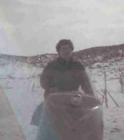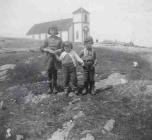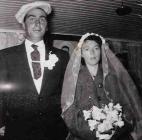1
Fishot Island is the name of a once prosperous fishing settlement located on the northeastern side of the island of Newfoundland. It is the largest in a group of islands which include the Cormandier Island, Massacre Island, Monk Island, Frommy Island, Verdon Island, and Pigeon Island. Due to the numerous islands in this area, the entrance to the harbour on Fishot Island is very narrow and only small boats can anchor within the harbour. In spite of this drawback Fishot Island was a favourable fishing Room of the French fishermen for at least four centuries.The French Shore Treaty of Newfoundland came into existence with the ratification of the Treaty of Utrecht(1713). This treaty provided the French fishermen the right to fish in season on the Newfoundland coast between Cape Bonavista and Point Riche. This area of Newfoundland had been frequented by fishermen from Brittany and Normandy since the early 16th century and which they called "le petit nord".
The "le petit nord" was scattered with fishing stations owned and operated by the French. One such place first appeared on French maps as Ille de Ficho in 1547. There are many explanations for this unusual name. One is that it is most likely derived from the French family name of Fishot and another is that it means a "post or staff fixed in the ground". In the early 1800's a man named Henry Bromley settled on Fishot Island and by 1858 the name had been anglanised to Fishrode Island.
Henry Bromley became a guardien for the French fishermen on Fishot Island. He took care of their property when they returned to France during the winter months. He soon married and started a family on the island. Because of the abundance of codfish and salmon in the vicinity of Fishot Island it was transformed from a French fishing station to a fixed populated settlement by 1850 including the family Aylward. Due to the increasing population a school and church were soon built. The Newfoundland settlers worked side by side with the French fishermen on the island.
The permanent settlers to the island survived on an economy of fishing - mainly salmon, cod, capelin and herring. Winter activities included hunting and woodcutting on the shores of Hare Bay, especially as there was no timber on the island itself. Agriculture was limited to root crops and a small number of livestock was raised. Even though the people of Fishot Island were very connected to the people in the surrounding communities, once Newfoundland joined Canada in 1949, they started to suffer from isolation, transportation difficulties and a lack of essential services. The population of the island kept increasing but this only accentuated the need for improved living conditions in the community. Between 1970 and 1972 resettlement, under the first Federal-Provincial resettlement agreement for the relocations of fishermen, took place from Fishot Island. The following photographs have captured a time period and a way of life for a community that went from a prosperous, close-knit fishing community to a people that scattered throughout Newfoundland and Canada.
2
Margaret and Joey Barrett 1959The following picture is quite unique. Not only was it unusual to have a dog as a pet, it was highly unusual for a dog to have its own house!
At the time, dogs were considered to be working animals used for hunting and travelling. Dogs were usually kept in large numbers in pounds or pens during the summer months and used to pull sleds during the winter.
4
Alice Alyward 1960Northern Newfoundland was still very isolated in 1960. Many communities did not have roads to connect them to each other. Modes of transportation included dog teams in the winter and boats in the summer. When the skidoo was introduced to many of these isolated communities it was with great excitement. Not only was this a faster mode of transportation it eventually replaced the dog teams as the common mode of transportion during the harsh winter months.
6
Saint Joseph's Church on Fishot Island, Newfoundland in the 1930's. This church was destroyed by a fire in the 1970's. Since the people of the community were beginning to be resettled by the Newfoundland government, the church was never replaced.8
Fred and Anastasia Buckle's wedding 1956In the early days, wedding celebrations were held in private homes. Weddings were a community event with everyone in the community in attendance.
10
Mary Anne, Alice and Leo AlywardThe following 1940 photo shows this family relaxing on the porch stoop on Fishot Island, Newfoundland. The water barrel, pictured in the background was a common fixture in homes without indoor plumbing. Buckets of water would be brought from a community stream or brook and poured into the barrel to be used by the family.




